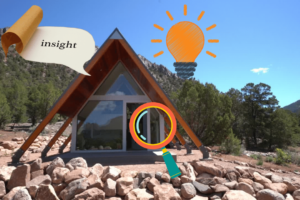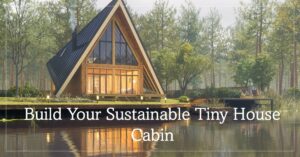Navigate the World of Tiny House Living: 10 Essential Insights to Consider

Tiny houses have captured the imagination of many, offering an alternative way of living that emphasizes minimalism and environmental consciousness.
If you’re considering embracing this lifestyle, you’re likely seeking information to make an informed decision. Let’s delve into the key aspects you need to know before leaping.
The Tiny House Movement: Embracing a New Way of Life
In recent years, a fascinating cultural phenomenon known as the “Tiny House Movement” has captured the imaginations and aspirations of individuals from all walks of life.
Beyond just a trend, this movement represents a paradigm shift in how we think about housing and lifestyle. Let’s take a closer look at the multifaceted world of the Tiny House Movement and why it has garnered such widespread appeal.
A Paradigm Shift
The Tiny House Movement challenges the conventional notions of what a home should be. It encourages people to rethink the very essence of homeownership. Rather than pursuing the stereotypical American Dream of owning a large house with a white picket fence, more and more individuals opt for a life of simplicity, sustainability, and freedom.
The Appeal of Tiny Living
So, what makes tiny living so appealing? The reasons are as diverse as the individuals who choose it:
- Simplicity: Tiny houses represent a break from the relentless pursuit of material possessions. By downsizing, people can focus on what truly matters to them, freeing themselves from the burden of excess stuff.
- Environmental Consciousness: With a smaller footprint, tiny houses have a significantly reduced impact on the environment. Many tiny homeowners embrace eco-friendly practices such as solar power and rainwater harvesting.
- Financial Freedom: The cost of a tiny house is often significantly lower than that of a traditional home, allowing for financial freedom and reduced stress related to mortgage payments.
- Mobility: Tiny houses on wheels offer the ultimate freedom. Owners can easily change their scenery, living in different places throughout the year while taking their homes with them.
- Community and Connection: The movement fosters a sense of community and connection. Tiny house enthusiasts often form tight-knit communities, sharing ideas, support, and resources.
Diverse Motivations
People join the Tiny House Movement for various reasons:
● Debt Reduction: Many are looking to escape the cycle of debt and find financial stability.
● Sustainability: Environmental concerns drive some to adopt a more sustainable way of life.
● Retirement Planning: Downsizing to a tiny house can be a smart retirement strategy, freeing up funds for other pursuits.
● Adventure: The freedom to travel and explore new places is a significant draw for some.
● Minimalism: Others are motivated by a desire to simplify and declutter their lives.
The Tiny House Community
The community aspect of the movement must be balanced. Tiny house enthusiasts often share their experiences, advice, and insights through social media, blogs, and in-person meet-ups. This sense of camaraderie helps those considering tiny living feel supported and empowered.
Budget and Financial Considerations
Tiny houses can be a more budget-friendly housing option, but they come with unique financial considerations. It’s crucial to clearly understand the costs involved, including construction or purchase, land, utilities, and ongoing maintenance. Being financially prepared ensures a smoother transition to tiny house living.
Here’s a table outlining the budget and financial considerations to keep in mind when planning for a tiny house:
| Expense Category | Description | Estimated Cost |
| Tiny House Construction | Building or purchasing your tiny house | $20,000 – $150,000 (varies widely based on size, materials, and location) |
| Land Purchase or Rent | Buying land or renting a space to park your tiny house | $5,000 – $100,000+ (depends on location and size of the land) |
| Utilities | Electricity, water, and sewage connections or off-grid solutions | Varies based on location and usage |
| Permits and Zoning | Costs associated with permits, inspections, and complying with local zoning laws | Varies widely by location |
| Insurance | Insurance coverage for your tiny house (similar to homeowners or RV insurance) | $500 – $1,500 per year |
| Maintenance and Repairs | Ongoing maintenance, repairs, and upgrades | Varies based on the condition and age of the tiny house |
| Furniture and Appliances | Furnishing your tiny house and purchasing appliances | $2,000 – $10,000+ |
| Storage Costs | If you need off-site storage for items you can’t fit in your tiny house | Varies based on location and size |
| Transportation | Costs related to moving your tiny house (for mobile tiny houses on wheels) | Varies based on distance and method |
| Emergency Fund | Setting aside funds for unexpected expenses or emergencies | Recommended 3-6 months’ worth of living expenses |
| Monthly Expenses | Includes ongoing costs like utilities, insurance, and potentially land rent | Varies widely based on lifestyle and location |
| Resale Value | Consider the potential resale value of your tiny house if you decide to sell it | Depends on market conditions and the condition of your tiny house |
Please note that these cost estimates are approximate and can vary significantly based on location, the size and complexity of your tiny house, whether you’re off-grid or connected to utilities, and your personal choices regarding materials and furnishings. Creating a detailed budget tailored to your specific circumstances is essential before embarking on your tiny house journey.
10 Things You Need to Know Before Buying a Tiny House
Before you embark on the journey of purchasing a tiny house, there are essential insights and considerations that you need to explore. So, whether you’re curious about the tiny house lifestyle or actively considering moving, let’s look at the ten things you need to know before buying a tiny house.
1. Budget and Financial Planning:
● Consider your budget carefully. Beyond the initial cost of the tiny house, factor in land or parking expenses, utilities, permits, maintenance, and potential hidden costs.
● Create a detailed financial plan to ensure you can comfortably afford the tiny house lifestyle.
2. Legal and Zoning Regulations:
● Investigate local zoning laws and building codes. Tiny houses may not be allowed everywhere, and regulations can vary significantly.
● Ensure your tiny house complies with local laws to avoid legal issues.
3. Space Optimization and Design:
● Understand the importance of efficient design in maximizing space.
● Explore space-saving furniture and storage solutions tailored to your needs and preferences.
4. Lifestyle Adjustment:
● Prepare for a lifestyle change. Downsizing means decluttering and simplifying your possessions.
● Embrace the concept of living with less and be ready for the psychological shift this entails.
5. Maintenance and Sustainability:
● Recognize that maintaining a tiny house can be more hands-on due to its compact size.
● Explore sustainable practices such as solar power, rainwater harvesting, and composting toilets to reduce your environmental impact.
6. Location and Community:
● Choose your location wisely. Urban, suburban, or rural settings offer different lifestyles and opportunities.
● Explore tiny house communities or networks for support, camaraderie, and shared resources.
7. DIY vs. Buying Pre-built:
● Decide whether to build your own tiny house or purchase a pre-built one.
● Weigh the pros and cons of each option, considering your skills, budget, and time availability.
8. Utilities and Off-Grid Considerations:
● Determine your approach to utilities. Are you connecting to city services, going off-grid, or relying on a combination?
● Plan for water, electricity, and waste management solutions tailored to your lifestyle.
9. Transportation (For Mobile Tiny Houses):
● If your tiny house is on wheels, consider transportation logistics.
● Understand the legal requirements and costs associated with moving your home, whether for relocation or travel.
10. Resale Value and Long-Term Planning:
● Think about the long-term. Consider the potential resale value of your tiny house if your circumstances change.
● Plan for the future by ensuring your tiny house meets your needs over time.
Remember that while the tiny house lifestyle offers many benefits, it also requires careful planning and adjustments. Take your time to research, budget, and prepare for the unique challenges and rewards of tiny house living.
Ultimately, being well-informed and making thoughtful choices will help ensure a successful transition to this exciting and minimalist way of life.
Conclusion
As you embark on your journey into the world of tiny house living, remember that knowledge is your most valuable asset.
By understanding these essential insights, you’re equipping yourself to make informed decisions and confidently embrace the tiny house lifestyle. Enjoy the adventure ahead!


